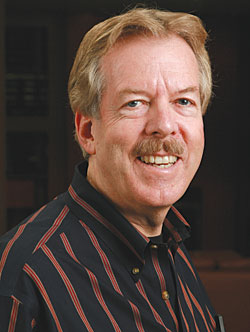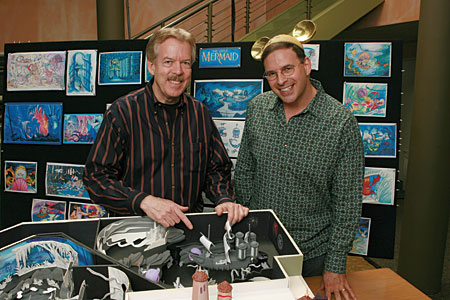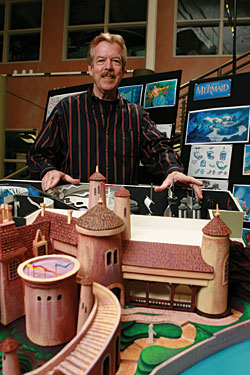HT Talks To . . . Tony Baxter of Walt Disney Imagineering
Here's a lost bit of Disneyland history gleaned from the new Little Mermaid Platinum Edition DVD: The film's overwhelming success prompted Disney Imagineers to dream up a new theme-park ride in its honor. But then the radiant accolades for the studio's Best Picture–nominated follow-up, Beauty and the Beast, promptly changed a fickle world's tune to "The Little Who-Now?" and Disney shelved the project. Disc two of the set caps this tale with one of the single most impressive bonus features ever conceived, fully realizing the ride that almost was through modern computer-generated imagery. It's authentic to the pseudo reality of Disney's parks, and you can view it with optional schematic drawings, commentary, and the ability to turn up the lights to reveal the inner workings of the accurately simulated machinery. It's all part of "Under the Sea Adventure: A Virtual Ride Inspired by Disney Imagineers."
In an industry where illusion is king, why reveal your tricks to any fan with a remote control? For the answers, I went to a nondescript industrial building in Glendale, California, to meet the man behind the curtain, Tony Baxter, senior vice president of Walt Disney Imagineering. WDI is an expansive gathering of some of the most brilliant minds in entertainment. They're responsible for every facet of the attractions at all of the Disney theme parks, resorts, and now, in-home entertainment, as well. Here, suspension of disbelief is both an art and a science.
 Do You classify yourself as an idea guy?
Do You classify yourself as an idea guy?
We all have formal titles here, like senior vice president, but that isn't what you do every day. You come in, and you get people inspired, and you build teams. Everybody gets enthused about something like The Little Mermaid, and they kind of carry it on further than any one person can. When we finally open something, there might be 500 people involved.
That's bigger than the crew of some feature films.
Yes, it is. Because, well, a film is essentially software. What we're doing is the hardware. In other words, we might have to invent the projection system that shows it or the ride system that shows it. And then, like an architect, we have to create a venue in which all of this will be presented.
And especially when Walt Disney first started doing this, it was all a new frontier.
Walt went to a good friend of his, Welton Becket, who was an architect, and said, "I need help. How am I going to build this Disneyland?" And he said, "Well, you got it right there at the studio: It's all your designers, architects, and animators. The way they think in terms of igniting people's emotions is far more important than getting the architecture right."
How long have you been doing this?
I grew up in the shadows of Disneyland and rode my bike there. When I turned 17, I got a job there scooping ice cream. Later, I worked all the rides in the park, and then, when I graduated from college with a degree in theater design, I came up to here, Imagineering, and I've been here since 1971.
What are some of the attractions you've worked on?
The first attraction that I got to lead the effort on was Big Thunder Mountain, which we now have four of all around the world. Then we did all of the original Fantasyland over. And then it was George Lucas who kind of ignited my next era, which was Indiana Jones; first we did Star Tours. Of course, George had captured the whole world, so we felt that needed to be at Disneyland and Walt Disney World, because those parks are so in touch with American pop myth.
When I was 23, I was convinced that heaven would be an endless loop of Star Tours.

[laughs] I think we felt that because nothing like it had ever been done before, you know? We were putting the first simulator into a theme-park environment where guests could use something that was for the military or for pilots in industrial airlines and so forth. You could go in and experience the same thing, and, really, all of these exciting moments from the films now became personal as you felt the effects of all the calamities firsthand.
Originally, your team worked on The Little Mermaid ride for three years?
On and off. It was going to be part of the second phase in our opening in Paris, right after we came online.
Be honest, How bummed were you when the powers that be pulled the plug?
Well, because you have so many different things, I was bummed that we weren't doing Little Mermaid, but I was thrilled that we got to do Space Mountain, which was what they chose to go forward with over there at the same time.
Sure, there's always another project ahead—that's a consolation. But you seem to get excited about all of them.
You do. And the speed with which new films and new characters have come to life at Disney, you can't really sit there and dwell on something that was part of the past. Snow White was probably the first of the "evergreens" that are never going to become dated. I think The Little Mermaid falls into that category. And so we get to revisit this and go on this journey of taking it into technologies that didn't exist when we created it back in 1989.
Even so, though, you guys have always been fairly hush-hush. Were there mixed feelings about sharing so many of your best-kept secrets on this DVD?
No, I'll tell you why. We are looking for all kinds of opportunities to be a creative vendor of ideas. And, to do a CG [computer-generated] ride, I think it's important to us from the public's standpoint. They're going to get to interface with a Disney-quality ride in a way that we've never been able to do before. You can turn the work lights on. You can go through the storyboards. You can see the blueprints. But it was a great experiment to see how effective we could be in getting the emotion that really is part of going through a Disney ride, getting that emotion out there onto the image that you'll see. And it was really clear to me that it's there in spades. Besides, you don't have to wait in line. You can go around again and again and again, as many times as you want.
You're also developing your own technologies on a fairly regular basis; You need to guard those, right?
Yes, our technologies are invisible. Like Indiana Jones—each vehicle is more complicated than some of our entire rides. I don't even want to go into how much money is in each one of those. After each vehicle is done, we throw mud all over it and decorate it to look like a falling-apart, ramshackle old troop transport. Because the whole story we're selling there is not one of modern technology taken to the zenith but something that's clunky and could derail at a moment's notice.
So, if you had built the ride, Ariel, Eric, and everyone else would have been animatronic? Is that still the correct word?
 Yes, it is. And animatronic ranges from fairly simple movements, like those of our undersea creatures—which were purposely created on the DVD in such a way that they're pretty simple animation, to show viewers not what we can do in CG but what we probably would have done had it come to life as a real ride. Other characters like Ariel and Eric would be given many more features because they are the lead characters.
Yes, it is. And animatronic ranges from fairly simple movements, like those of our undersea creatures—which were purposely created on the DVD in such a way that they're pretty simple animation, to show viewers not what we can do in CG but what we probably would have done had it come to life as a real ride. Other characters like Ariel and Eric would be given many more features because they are the lead characters.
Have the animatronics themselves changed much since the old days of The Hall of Presidents?
Yeah, I think a lot of the development went on about a decade ago when we came up with a thing we call "compliance," which allows the figure to sense when it's reaching the end of a movement. That allowed us to create a lot more fluid and alive motion and get very, very sophisticated in how these guys can move.
Does it help when you and your team are big fans of a particular movie that you're adapting into an attraction?
Absolutely. I played hooky from work the day they were sneaking Raiders of the Lost Ark in Pasadena, and I remember coming out saying, "Wouldn't that make the most fantastic adventure ride that anyone has ever experienced?" But it was 1981, and there was no technology to do that. So, we had to just put it on the back burner and allow technology to come up to where it could deliver a totally unpredictable experience.
I should tell you that, the one time I rode it, in 1995, it was the longest line I've ever waited in.
That was the year it opened. Well, the problem you have is, you have a movie title like that, where it played in 3,000 theaters, and suddenly the new episode is in one theater—only at Disneyland, essentially.
On a ride like that, or even more so with The Little Mermaid ride, you have to shrink it down to four minutes, so you guys need to be really good story editors, too.
Well, if the movie has done as good a job as The Little Mermaid did in getting the public to fall in love with Ariel, you know you've got strong characters, and they're almost iconic, so we don't have to spend the amount of time necessary to endear the character to you. We have to deliver the environments and the emotion. And then, because we want to be entertainers, we looked for the two set pieces. Well, "Under the Sea" won an Academy Award. And then "Kiss the Girl" felt like the happily-ever-after moment, so we took those as our bookends.
This virtual ride comes a generation after the movie was first released, but it's as if not a day has passed.
I've got to create products that still excite me and the generations that are traditional Disney-philes, but I've also got to find hooks in it to get this new group excited about it. So, when [Disney] Home Entertainment came to us with the thought of doing a CG attraction where viewers control it, it was fascinating to me, because that's where all of these new technologies are taking our sister products. Like you can buy songs online—imagine Walt Disney thinking that Snow White would be rolling along on the black rubber mat with the broccoli, the milk, and the eggs, being digitally counted, and then thrown into a brown paper bag. His generation couldn't have imagined that. DVD is now the leading form of how people consume film product.
Coming full circle then, The Little Mermaid has gone on to take its place in the Disney canon as one of the modern masterpieces. So, do you think this ride might still get built?
I'll tell you, I'm always surprised by what happens here, and I think that the real exciting thing about The Little Mermaid is—as you just said—it is part of the Disney canon of classics. I don't know whether it's the spirituality of it or the emotion in it, but it resonates with people. Who knows? With all the impressions that'll be made, it very well might come to be.
* Special thanks to Marilyn Waters of WDI, Karen Penhale of Carl Samrock Public Relations, and Chris Bess and Rick Rhoades of Buena Vista Home Entertainment.
- Log in or register to post comments




































































